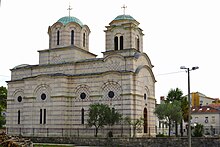St. Sava Church (Tivat)
The Church of St. Sava ( Serbian : Црква Светог Саве, Crkva Svetog Save) is a Serbian Orthodox church in the port city of Tivat in southwestern Montenegro
The church, built between 1940 and 1966, is dedicated to the Serbian national saint, the first archbishop and the illuminator of the Serbian people, Sava of Serbia . It is the parish church of the parishes Tivat I and Tivat II in the deanery of the Bay of Kotor , the metropolitan area of Montenegro and the coastal land of the Serbian Orthodox Church .
location
The fenced church stands in the middle of the churchyard, in the center of Tivat. Its west side is on Prevlačka ulica. The main street Jadranska Magistrala runs through the city directly on its east side . The rectory is not far from the church.
history
With the growth of the city in the 20s and 30s of the 20th century, mainly due to the influx of Orthodox believers, it was necessary to build a new, large Serbian Orthodox church in Tivat. On January 27, 1931, the Slava of St. Sava, a church building committee was established.
As there were differences between the Tivat city authorities and the faithful, it was difficult to find the right location to build the church. In 1939 the plans to build the church made more rapid progress with the arrival of Father B. Milošević. In 1940 a suitable building site was found in the middle of the city center. On May 19, 1940, the then Metropolitan Joanikije (Lipovac) announced that the church should be consecrated to St. Sava.
And on September 22, 1940, the foundation stone of the church was solemnly consecrated by the then Patriarch of His Holiness Gavrilo V (Dožić) in the presence of 5000 believers. By April 1941, when World War II reached what was then the Kingdom of Yugoslavia , the church was almost completely finished.
In the first days of April 1941, during the Balkan campaign , the Italians, allied with Germany , bombed Tivat and caused enormous damage to the city. The Church of St. Sava was also badly destroyed. The further construction could not be continued in the war years.
After the end of World War II, was built by the Tito - Partisans , the socialist Yugoslavia established. The construction of the church could only be continued with enormous efforts. In 1966 the church was completed.
And on September 10, 1967, the church was given to the then Patriarch of His Holiness German (Đorić) , with the assistance of the then Metropolitan of the Metropolitan Region of Montenegro and the Coastal Country Danilo (Dajković) , the Bishop of the Eparchy of Upper Karlovac Simeon (Zloković) and the Bishop of the Eparchy of Dalmatia Stefan (Boca) in the presence of hundreds of believers.
The church suffered great damage in the great earthquake of 1979 . The first restoration took place in 1995 and the second in 2005. On January 27, 1999, the Metropolitan Metropolitan Amfilohije (Radović) inaugurated the foundations of the rectory.
In 2017, the church celebrated the 50th anniversary of church consecration. The church has its own church choir under the direction of Nataša Pavlović .
The church is the seat of the two parishes of Tivat and the parish of the same name. The priest of the first parish of Tivat and high priest of the church is Archpriest Savo Denda (he was present at the church consecration as a young boy) and the priest of the second parish of Tivat is Archpriest Petar Petrović.
architecture
The cross-domed church is designed in the form of a trikoncho and its structure is reminiscent of the medieval Morava school , a traditional style of the Serbian-Byzantine architectural style .
The plan of the church is an elongated Greek cross , with a semicircular altar - apse in the east and a central round dome that rises above the drum in the middle of the nave . On the west side of the church is the steeple with the main entrance to the church. There is another entrance to the church on the south side.
Typical for Orthodox church buildings, it has a (wooden) iconostasis with icons . The interior of the church is not currently frescoed , but the interior of the church has been planned since 2017.


